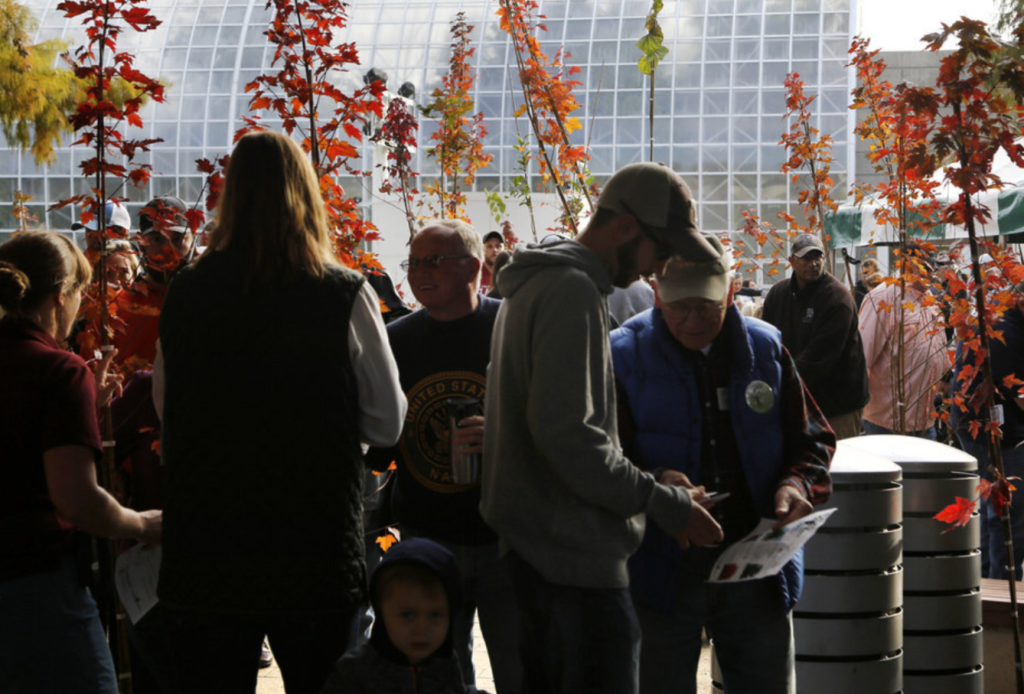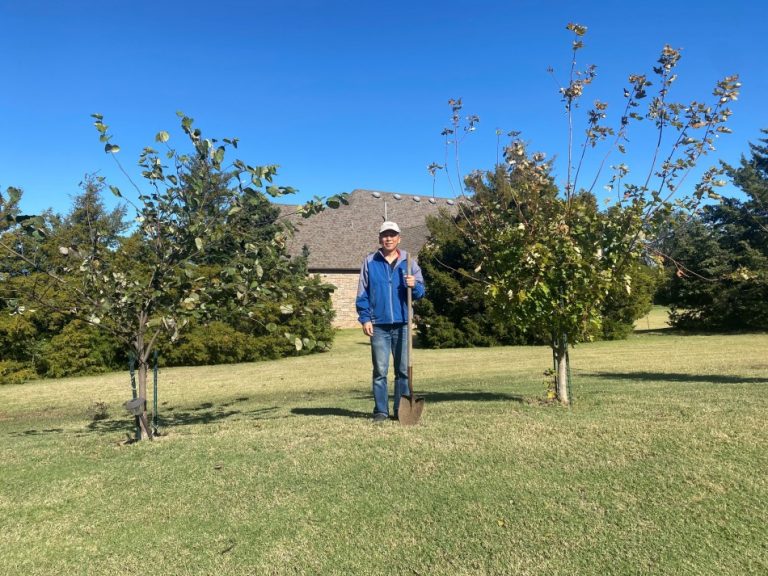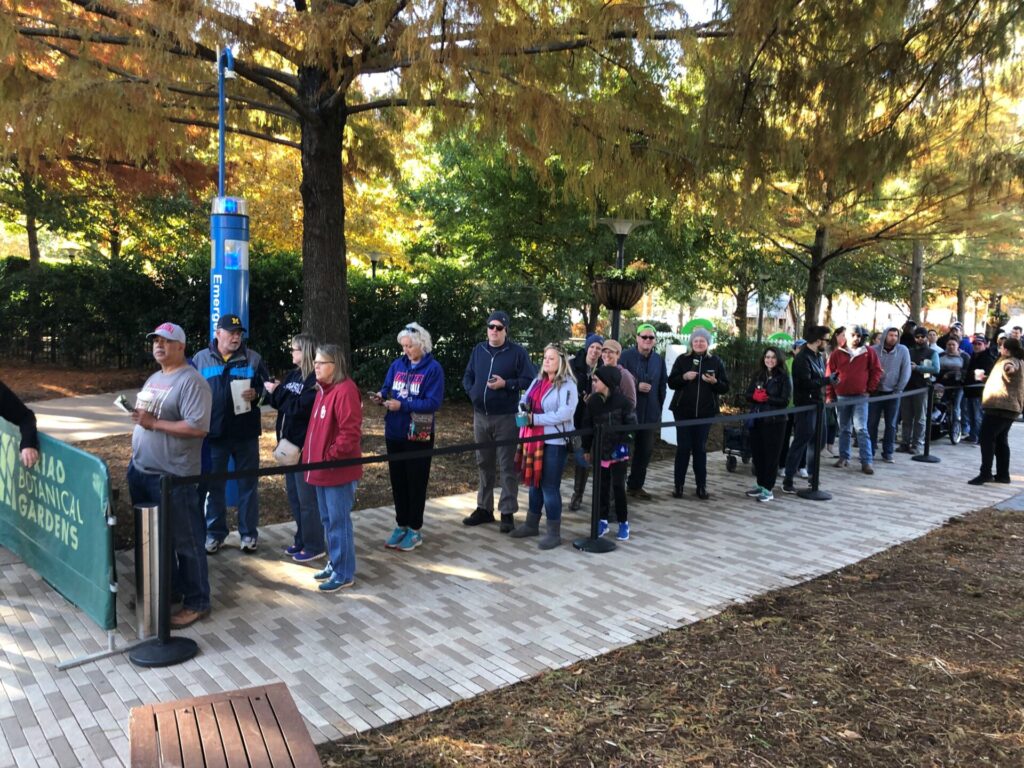405-445-7080
301 W. Reno
Oklahoma City, OK 73102
Crystal Bridge: Ticket Required
Open daily, 9am-5pm;
Sunday, 11am-5pm
Outdoor Grounds: Open daily 6am-11pm
405-445-7080
301 W. Reno
Oklahoma City, OK 73102
Crystal Bridge: Ticket Required
Open daily, 9am-5pm;
Sunday, 11am-5pm
Outdoor Grounds: Open daily 6am-11pm


One-gallon Redbud trees will be given away to the first 50 visitors on the day of the sale.
Devon Lawn
9-10AM – Presale Pickup
10AM-1PM – Onsite Sales
$20 and $25 per tree
Our annual tree sale, Tree for All, returns bigger and better at Devon Lawn! This program is designed to assist homeowners as they promote natural beautification and improvement of the environment through the planting of trees. Our goal is to diversify the green canopy in Oklahoma and ensure a sustainable and biodiverse landscape. Trees will be available for purchase in 3- and 5- gallon sizes with vendors, exhibitors, and educational programming scheduled throughout the day.
A special thank you goes to our presenting sponsor, Cox, for their generous support and commitment to our cause.
This Year’s Tree Selections:
Purchase Options
General online sale starts on Saturday, November 1, at 8AM.
All online sales close on Thursday, November 6, at 5PM.
To make online purchases, click on the tree names below. Each tree variety has a separate purchase page.
Vendors:
Schedule of Events:
Parking and Pickup
Bald Cypress
Taxodium distichum

The Bald Cypress is a deciduous (loses its leaves in fall) conifer (cone bearing tree). It is covered with brown or gray bark with long fiber-like or scaly ridges that peel off in strips. Cones are made up of several four-angled, flattened scales. Limbs are often draped with Spanish moss (Tillandsia usneoides).
River Birch
Betula nigra

River birch is a medium-sized tree growing 40 to 70 feet tall and 40 to 60 feet wide. In its native habitat, river birch occurs in full to part sun in floodplains and along streams. It can be grown as a single or multi-stemmed tree and is prized for its papery peeling bark and golden-yellow fall color.
Brandywine Red Maple
Acer rubrum ‘Brandywine’

Acer rubrum, commonly called red maple, is a medium-sized, deciduous tree that is native to Eastern North America from Quebec to Minnesota south to Florida and eastern Texas. It typically grows 40-60’ tall with a rounded to oval crown. It grows faster than Norway and sugar maples, but slower than silver maple.
Loblolly Pine
Pinus taeda

Loblolly pines are classified as yellow, also known as hard pines, because of their resinous, hardwood. They are primarily planted in the southern United States for their lumber but have many other uses, including pulp, boxes, crossties, posts, and fuel. Loblolly pines can live for as long as 275 years.
Roughleaf Dogwood
Cornus drummondii

The roughleaf dogwood is a large shrub or small tree that grows to about 6–15 feet tall and wide, with oval, rough-textured leaves that turn purplish-red in the fall. It features clusters of small, yellowish-white flowers in the spring and produces hard, white fruit later in the year. Known for its toughness, this plant tolerates a variety of soils and is often used for wildlife cover, erosion control, and naturalistic plantings.
Sweetgum
Liquidambar styraciflua

A sweetgum tree is a large deciduous tree with star-shaped, glossy green leaves that turn vibrant red, yellow, purple, or orange in the fall. Its bark is gray-brown and deeply furrowed, while young branches may have characteristic corky wings. In winter, the tree is recognized by its spiky, woody fruit balls, known as “gumballs,” which can be a nuisance on the ground.
Texas Redbud
Cercis canadensis var. texensis

A reliable Oklahoma native small tree, the redbud grows upwards of 10 – 20 feet tall. This redbud has glossy heart shaped leaves and blooms a vibrant purple in the early spring. It is more drought tolerant than its relative Eastern Redbud, and is smaller in stature. The seed pods emerge a reddish brown and provide food for birds and winter interest.
Sweetbay Magnolia
Magnolia virginiana

Like other magnolias, the sweetbay magnolia has a large flower that turns into a cone like fruit with attractive, bright red seeds that birds love. The white, cup shaped flower of the sweetbay magnolia has 9-12 waxy pedals that put off a sweet smell.
Mexican Plum
Prunus Mexicana

Mexican plum is a small fruit tree native to Oklahoma and much of the south central United States. It typically grows with a single trunk without suckering and reaches anywhere from 15 to 25 feet in height. Heavily scented white flowers cover the whole tree in late spring or early summer. Its fruit is about an inch in diameter and matures in late summer to a dark purple color. The bark is also attractive, with exfoliating patches and reddish color in it. Sometimes the fall foliage is orange of red.
Southern Magnolia
Magnolia grandiflora

Southern magnolia (Magnolia grandiflora), also called evergreen magnolia, bull-bay, big-laurel, or large-flower magnolia, has large fragrant white flowers and evergreen leaves that make it one of the most splendid of forest trees and a very popular ornamental that has been planted around the world.
See our photo album from last year’s Tree For All!
The annual Tree for All presented by Cox is the second Saturday of November! We’ll announce the trees for sale as we get closer.
Our mission is to promote natural beauty and environmental improvement through tree planting. By diversifying Oklahoma’s green canopy, we strived to create a sustainable and biodiverse landscape.
By Nate Tschaenn

“We absolutely love the trees we purchased a few years ago at the annual Tree For All event. Thank you to Cox Communications and the Myriad Botanical Gardens for putting on such an amazing event. These hardy trees have braved the wild Oklahoma ice storms and freezes. It feels good knowing we are making a difference in the environment all while beautifying our yard!”
-William and Jenni Choi, Edmond, Oklahoma


